IIT JAM PHYSICS 2015
Previous Year Question Paper with Solution.
1. A system consists of N number of particles, N >> 1. Each particle can have only one of the two energies E1 or E1 +  . If the system is in equilibrium at a temperature T, the average number of particles with energy E1 is
. If the system is in equilibrium at a temperature T, the average number of particles with energy E1 is
(a) 
(b) 
(c) 
(d) 
Ans. (c)
Sol. 
Now N1 + N2 = N M – B distribution

Now, N1 + N2 = N

2. Temperature dependence of resistivity of a metal can be described by
(a) 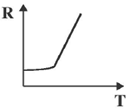
(b) 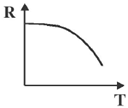
(c) 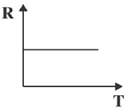
(d) 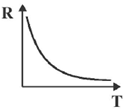
Ans. (a)
Sol. We know that total resistivity of a metal is given by

 is residual resistivity, is due to scattering by impurities. This is independent of temperature
is residual resistivity, is due to scattering by impurities. This is independent of temperature
 is called the ideal resistivity, is due to scattering phonons. This is temperature dependent
is called the ideal resistivity, is due to scattering phonons. This is temperature dependent

3. A charge q is at the centre of two concentric spheres. The outward electric flux through the inner sphere is  while that through the outer sphere is 2
while that through the outer sphere is 2 . The amount of charge contained in the region between the two sphere is
. The amount of charge contained in the region between the two sphere is
(a) 2q
(b) q
(c) –q
(d) –2q
Ans. (b)
Sol. For sphere 1:

For sphere 2:

Therefore charge enclosed by outer sphere is twice charge enclosed by inner sphere.
Therefore charge contained in region between two sphere must be q.
4. At room temperature, the speed of sound in air is 340 m/sec. An organ pipe with both ends open has a length L = 29 cm. An extra hole is created at the position L/2. The lowest frequency of sound produced is
(a) 293 Hz
(b) 586 Hz
(c) 1172 Hz
(d) 2344 Hz
Ans. (c)
Sol. Effective length of organ pipe


5. A proton from outer space is moving towards earth with velocity 0.99c as measured in earth's frame. A spaceship, traveling parallel to the proton, measures proton's velocity to be 0.97 c. The approximate velocity of the spaceship, in the earth's frame is
(a) 0.2c
(b) 0.3c
(c) 0.4c
(d) 0.5c
Ans. (c)
Sol. 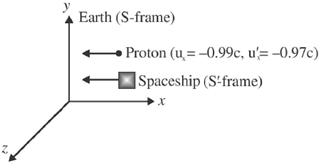
According to velocity-addition theorem

where, ux = velocity of the proton w.r.t. earth i.e. S frame = –0.99 c
u'x = velocity of the proton w.r.t. spaceship i.e. S´ frame = –0.97 c
v = velocity of the spaceship w.r.t. earth i.e. S frame


6. A particle with energy E is incident on a potential given by

The wave function of the particle for E < V0, in the region x > 0 (in terms of positive constants A, B and k) is
(a) Aekx + Be–kx
(b) Ae–kx
(c) Aeikx + Be–ikx
(d) Zero
Ans. (b)
Sol. 
Time independent Schrodinger equation for the region x > 0 is,
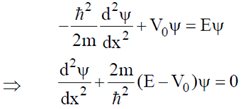
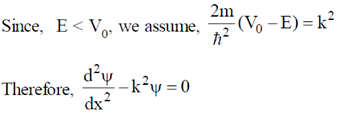

7. The electric field of a light wave is given by

The polarization state of the wave is
(a) Left handed circular
(b) Right handed circular
(c) Left hand elliptical
(d) Right handed elliptical
Ans. (c)
Sol. We have,
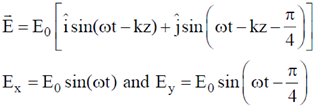
From the analysis of Lissajou figures

We know that this is the equation ellipse.
For the handedness.

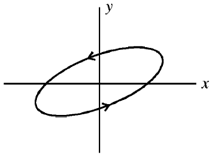
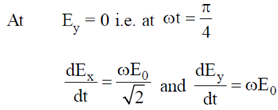
Both are positive. So the figure is like
This is the left handed ellipse.
8. A mass m, lying on a horizontal, frictionless surface, is connected to one end of a spring. The other end of the Spring is connected to a wall, as shown in the figure. At t = 0, the mass is given an impulse
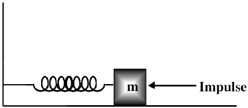
The time dependence of the displacement and the velocity of the mass (in terms of non-zero constants A and B) are given by
(a) 
(b) 
(c) 
(d) 
Ans. (a)
Sol. 
Option (a) satisfies this condition
9. Consider the coordinate transformation  . The relation between the area elements dx'dy' and dxdy is given by dx'dy' = jdxdy. The value of J is
. The relation between the area elements dx'dy' and dxdy is given by dx'dy' = jdxdy. The value of J is
(a) 2
(b) 1
(c) –1
(d) –2
Ans. (c)
Sol. 
Relation between the area elements:
dx'dy' = Jdxdy
where J is jacobian of (x´, y´) w.r.t. (x, y) and given by
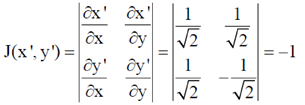
10. The trace of a 2 × 2 matrix is 4 and its determinant is 8. If one of the eigenvalue is 2(1 + i), the other eigenvalue is
(a) 2(1 – i)
(b) 2(1 + i)
(c) (1 + 2i)
(d) (1 – 2i)
Ans. (a)
Sol. Sum of the eigenvalues = Trace of the matrix

11. A hollow, conducting spherical shell of inner radius R1 and outer radius R2 encloses a charge q inside, which is located at a distance d(< R1) from the centre of the spheres. The potential at the centre of the shell is
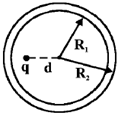
(a) zero
(b) 
(c) 
(d) 
Ans. (d)
Sol. Due to induction –q and +q charges appear on the inner and outer surface of the shell.
So, potential at center will be

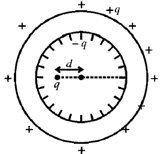
12. Doppler effect can be used to measure the speed of blood through vessels. Sound of frequency 1.0522 MHz is sent through the vessels along the direction of blood flow. The reflected sound generates a beat signal of frequency 100 Hz. The speed of sound in blood is 1545 m/sec. The speed of blood through the vessel, in m/sec, is
(a) 14.68
(b) 1.468
(c) 0.1468
(d) 0.01468
Ans. (c)
Sol. Let we denote the velocity of blood by vB. Since the blood is flowing in the direction of propagation of wave. So, the frequency of reflected wave is

where, v0 = 1.0522 MHz, v = 1545 m/s beat frequency = 100 Hz
= 100 × 10–6 MHz = 0.0001 MHz = v0 – v´.
So, v'v = v0v – v0vB

13. Vibrations of diatomic molecules can be represented as those harmonic oscillators. Two halogen molecules X2 and Y2 have fundamental vibrational frequencies vx = 16.7 × 1012 Hz and vy = 26.8 × 1012 Hz respectively. The respective force constants are Kx = 325 N/m and KY = 446 N/m. The atomic masses of F, Cl and Br are 19.0, 35.5 and 79.9 atomic mass unit respectively. The halogen molecules X2 and Y2 are
(a) X2 = F2 and Y2 = Cl2
(b) X2 = Cl2 and Y2 = F2
(c) X2 = Br2 and Y2 = F2
(d) X2 = F2 and Y2 = Br2
Ans. (b)
Sol. Vibrational frequencies can be written as 
where k is the force constant and m is the reduced mass of the diatomic molecules.

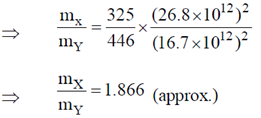
14. The variation of binding energy per nucleus with respect to the mass of nuclei is shown in the figure
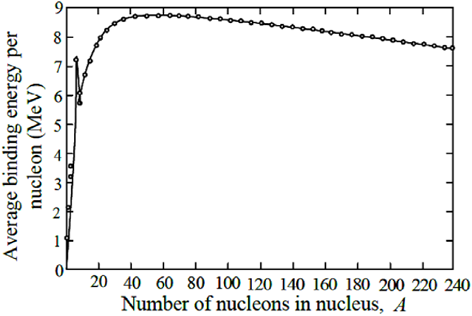
Consider the following reactions:

which one of the following statements is true for the given decay modes of  ?
?
(a) both 1 and 2 are allowed
(b) both 1 and 2 are forbidden
(c) 1 is forbidden and 2 is allowed
(d) 1 is allowed and 2 is forbidden
Ans. (c)
Sol.  is a radioactive element and will decay into various daughter nuclei by emitting
is a radioactive element and will decay into various daughter nuclei by emitting  and
and  particle.
particle.

By the emission of p and n, atomic number decreases by 10 units and number is decreased by 32 units. i.e. there should be 8 number of  -emission and 6 number of
-emission and 6 number of  -emission.
-emission.

So, first reaction is forbidden and second reaction is allowed.
15. A rigid and thermally isolated tank is divided into two compartments of equal volume V, separated by a thin membrane. One compartment contains one mole of an ideal gas A and the other compartment contains one mole of a different ideal gas B. The two gases are in thermal equilibrium at a temperature T. If the membrane ruptures, the two gases mix. Assume that the gases are chemically inert. The change in the total entropy of the gases on mixing is
(a) 0
(b) R ln 2
(c) 
(d) 2R ln 2
Ans. (d)
Sol. The change in entropy due to diffusion / mixing of any number of inert gases is equal to h.

where, nj is number of moles of jm gas.
xj is mole fraction of jm gas.
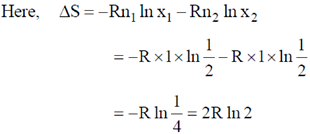
16. A zener regulator has an input voltage in the range 15V – 20 V and a load current in the range of 5 mA – 20 mA. If the zener voltage is 6.8 V, the value of the series resistor should be
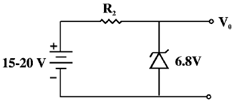
(a) 
(b) 
(c) 
(d) 
Ans. (b, c, d)
Sol. 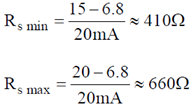
Any of the 3 options satisfied (b), (c), (d)
17. A positively charged particle, with a charge q, enters a region in which there is a uniform electric field and a uniform magnetic field  , both directed parallel to the positive y-axis. At t = 0, the particle is at the origin and has a speed v0 directed along the positive x-axis. The orbit of the particle, projected on the x-z plane, is a circle. Let T be the time taken to complete one revolution of this circle. The y-coordinate of the particle at t = T is given by
, both directed parallel to the positive y-axis. At t = 0, the particle is at the origin and has a speed v0 directed along the positive x-axis. The orbit of the particle, projected on the x-z plane, is a circle. Let T be the time taken to complete one revolution of this circle. The y-coordinate of the particle at t = T is given by
(a) 
(b) 
(c) 
(d) 
Ans. (b)
Sol. Displacement in y-direction will arise due to electric force.


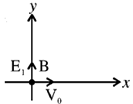
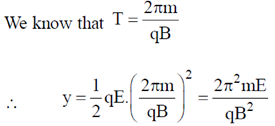
18. A satellite moves around the earth in a circular orbit of radius R centered at the earth. A second satellite moves in an elliptic orbit of major axis 8R, with the earth the one of the foci. If the former takes 1 day to complete a revolution, the letter would take
(a) 21.6 days
(b) 8 days
(c) 3 hours
(d) 1.1 hours
Ans. (b)
Sol. Using Keplers third law we get
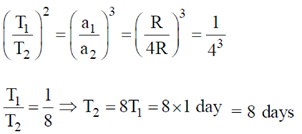
19. A system comprise of three electrons. There are three single particle energy levels accessible to each of these electrons. The number of possible configurations for this system is
(a) 1
(b) 3
(c) 6
(d) 7
Ans. (d)
Sol. Number of possible configuration

20. A rigid triangular molecule consists of three non-collinear atoms joined by rigid rods. The constant pressure molar specific heat (CP) of an ideal gas consisting of such molecules is
(a) 6R
(b) 5R
(c) 4R
(d) 3R
Ans. (c)
Sol. For a rigid triangular molecule.

Here, f = 3 + 3 = 6

Or, CV = 3R
Or, CP = Cv + R = 4R
21. Consider the equation  with the boundary condition y(1) = 1. Out of the following, the range of x in which y is real and finite, is
with the boundary condition y(1) = 1. Out of the following, the range of x in which y is real and finite, is
(a) 
(b) 
(c) 
(d) 
Ans. (d)
Sol. 
Applying the condition, y(1) = 1
We get, c = –1

22. Consider a vector field  . Let C be the circle x2 + y2 = 4 on the plane z = 2, oriented counter-clockwise. The value of contour integral
. Let C be the circle x2 + y2 = 4 on the plane z = 2, oriented counter-clockwise. The value of contour integral  is
is
(a) 
(b) 
(c) 
(d) 
Ans. (a)
Sol. 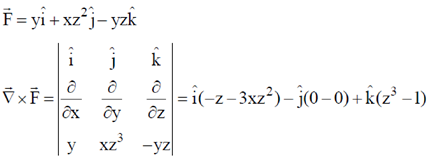
Now, using stoke's theorem

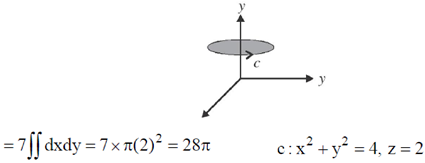
23. Which of the following circuits represent the Boolean expression 
(a) 
(b) 
(c) 
(d) 
Ans. (b)
Sol. 
24. Seven uniform disks, each of mass m and radius r, are inscribed inside a regular hexagon, as shown. The moment of inertia of this system of seven disks, about an axis passing through the central disk and perpendicular to the plane of the disks, is
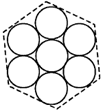
(a) 
(b) 7 mr2
(c) 
(d) 
Ans. (d)
Sol. Moment of inertia of disc 2 about a perpendicular axis through center of disc 1 is

Therefore, total moment of inertia of system given is
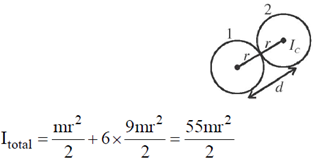
25. A nucleus has a size of 10–15 m. Consider an electron bound within a nucleus. The estimated energy of this electron is of the order of
(a) 1 MeV
(b) 102 MeV
(c) 104 MeV
(d) 106 MeV
Ans. (b)
Sol. Nucleus size  10–15 m
10–15 m
Maximum uncertainty in the position of the particle (e–) within the nucleus  = 10–15 m
= 10–15 m
So, minimum uncertainty in the momentum of the particle (e–)

Energy of the electron within the nucleus.


26. A conducting wire is in the shape of a regular hexagon, which is inscribed inside an imaginary circle of radius R, as shown. A current I flows through the wire. The magnitude of the magnetic field at the centre of the circle is
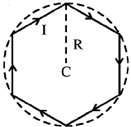
(a) 
(b) 
(c) 
(d) 
Ans. (c)
Sol. Magnetic field at C due to one side of hexagon is
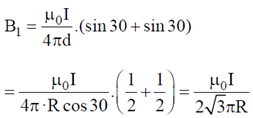
Total magnetic field at the center

27. An observer is located on a horizontal, circular turntable which rotates about a verticle axis passing through its centre, with a uniform angular speed of 2 rad/sec. A mass of 10 grams is sliding without friction on the turntable. At an instant when the mass is at a distance of 8 cm from the axis, it is observed to move towards the centre with a speed of 6 cm/sec. The net force on the mass, as seen by the observer at that instant, is
(a) 0.0024N
(b) 0.0032 N
(c) 0.004 N
(d) 0.006 N
Ans. (c)
Sol. Net force on observer is resultant of centrifugal and coriolis forces
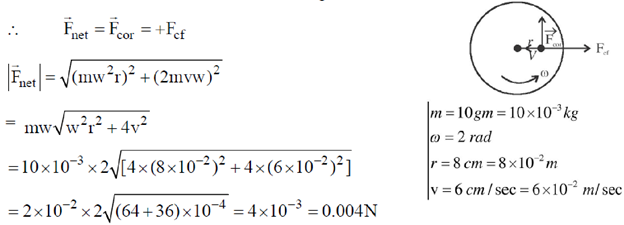
28. The Fourier series for an arbitrary periodic function with period 2L is given by  . For the particular periodic function shown in the figure, the value of a0 is
. For the particular periodic function shown in the figure, the value of a0 is
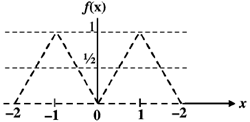
(a) 0
(b) 0.5
(c) 1
(d) 2
Ans. (c)
Sol. Functional form:


29. Miller indices of a plane in cubic structure that contains all the directions [100], [011] and [111] are
(a) (011)
(b) (101)
(c) (100)
(d) (110)
Ans.
Sol. All options are wrong.
30. The phase of the complex number (1 + i)i in the polar representation is
(a) 
(b) 
(c) 
(d) 
Ans. (c)
Sol. z = (1 + i) i = i – 1 = –1 + i
Phase of complex number

31. For an electromagnetic wave travelling in free space, the electric field is given by  . Which of the following statements are true?
. Which of the following statements are true?
(a) The wavelength of the wave in meter is 6
(b) The corresponding magnetic field is directed along the positive z-direction
(c) The poynting vector is directed along the positive z-direction
(d) The wave is linearly polarized.
Ans. (a, d)
Sol. 
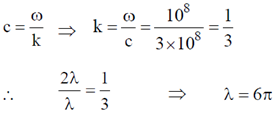

Magnetic field is in negative z-direction poynting vector is indirection of propagation (–x)
32. A particle of mass m is moving in x-y plane. At any given time t, its position vector is given by  , where A, B and
, where A, B and  are constants with A
are constants with A  B. Which of the following statements are true?
B. Which of the following statements are true?
(a) orbit of the particle is an ellipse
(b) speed of the particle is constant
(c) at any given time t, the particle experiences a force towards origin
(d) the angular momentum of the particle is 
Ans. (a, c, d)
Sol. 
Its a superposition of two SHM's, of unequal amplitude and phase difference of  . So, orbit is elliptical.
. So, orbit is elliptical.


33. Muons are elementary particles produced in the upper atmosphere. They have a life time of 2.2 µs. Consider muons which are travelling vertically towards the earth's surface at a speed of 0.998c. For an observer on earth, the height of the atmosphere above the surface of the earth is 10.4 km. Which of the following statements are true?
(a) the muons can never reach earth's surface.
(b) the apparent thickness of earth's atmosphere in muon's frame of reference is 0.96 km.
(c) the lifetime of muons in earth's frame of reference is 34.8 µs
(d) muons travelling at a speed greater than 0.998c reach the earth's surface.
Ans. (c, d)
Sol. Proper life time of the muon  (w.r.t. body frame of muon) = 2.2 µs
(w.r.t. body frame of muon) = 2.2 µs
Speed of muon w.r.t. observer on earth, v = 0.998 c.
Lifetime of muon w.r.t. earth's frame

Proper thickness of earth's atmosphere in earth's frame L = 10.4 km.
Apparent thickness of earth's atmosphere in muon's frame.

Time taken by the muon to reach the earth's surface in earth frame.


As the speed of the muon increases, life time of the muon increases and time taken by the muon to reach earth's surface decreases.
34. In an ideal op-amp circuit shown below, R1 = 3 and R2 = 1
and R2 = 1 and Vi = 0.5 sin
and Vi = 0.5 sin  (in volt). Which of the following statements are true?
(in volt). Which of the following statements are true?
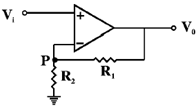
(a) the current through R1 = the current through R2.
(b) the potential at P is 
(c) the amplitude of V0 is 2V.
(d) the output voltage V0 is in phase with Vi.
Ans. (a, c, d)
Sol. The current through R1 and R2 are same
(A) (a) satisfied (B) (b) wrong (C) (c) satisfied (D) (d) satisfied
35. Consider the circuit consisting of an AC function generator V(t) = V0 sin  with V0 = 5V, an inductor L = 8.0 mH, resistor R = 5W and a capacitor C = 100 µF. Which of the following statements are true if we vary the frequency?
with V0 = 5V, an inductor L = 8.0 mH, resistor R = 5W and a capacitor C = 100 µF. Which of the following statements are true if we vary the frequency?
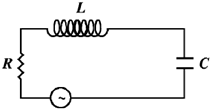
(a) the current in the circuit would be maximum at v = 178 Hz.
(b) the capacitor reactance increases with frequency
(c) at resonance, the impedance of the circuit is equal to the resistnace in the circuit
(d) at resonance, the current is out of phase with source voltage.
Ans. (a, c)
Sol. Resonance frequency,

(a) satisfied (b) failed (c) satisfied (d) wrong
36. The following figure shows a double slit Fraunhofer diffraction pattern produced by two slits, each of width a, separated by a distance b, a < b. Which of the following statements are correct?
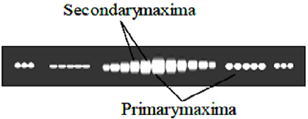
(a) reducing a increases the separation between consecutive primary maxima
(b) reducing a increases the separation between consecutive secondary maxima
(c) reducing b increases the separation between consecutive primary maxima
(d) reducing b increases the separation between consecutive secondary maxima
Ans. (a, d)
Sol. Here the primary maxima are the diffraction maxima.
We know that spacing between diffraction maxima increases by decreasing the slit width a. Within the diffraction maxima, secondary maxima occur due to interference and by decreasing b the spacing between secondary maxima increases. So, a has effect only on the primary maxima (diffraction maxima) while b has effect only on secondary maxima (interference maxima within the diffraction maxima). It should be noted that for primary maxima condition for diffraction as well as interference maxima must be satisfied.
37. A rod is hanging vertically from a pivot. A particle, travelling in horizontal direction, collides with the rod as shown in the figure. For the rod-particle system. Consider the linear momentum and the angular momentum about the pivot. Which of the following statements are not true?

(a) both linear momentum and angular momentum are conserved
(b) linear momentum is conserved but angular momentum is not
(c) linear momentum is not conserved but angular momentum is conserved.
(d) neither linear momentum nor angular momentum are conserved.
Ans. (b, c, d)
Sol. If we assume that it is about just before and just after collision then angular momentum about the pivot is conserved.
However if instants just before and just after collision is not considered and gravity is assumed to be present then neither linear momentum nor angular momentum is conserved.
38. As shown in the P-V diagram. AB and CD are two isotherms at temperatures T1 and T2 respectively (T1 > T2). AC and BD are two reversible adiabats. In this Carnot cycle, which of the following statements are true?
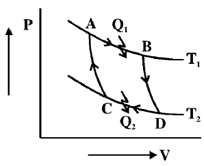
(a) 
(b) the entropy of the source decreases
(c) the entropy of the system increases
(d) work done by the system W = Q1 – Q2
Ans. (a, d)
Sol. As the cycle is Carnot.


In a reversible carbon cycle, the entropy change of system as well as source is zero.
39. A unit cube made of dielectric material has a polarization  units. The edges of the cube are parallel to the Cartesian axes. Which of the following statements are true?
units. The edges of the cube are parallel to the Cartesian axes. Which of the following statements are true?
(a) the cube carries a volume bound charge of magnitude 5 units.
(b) there is a charge of magnitude 3 units on both the surfaces parallel to the y-z plane
(c) there is a charge of magnitude 4 units on both the surfaces parallel to the x-z plane.
(d) there is a net non-zero induced charge on the cube
Ans. (b, c)
Sol. 
So volume bound charge in zero.
Now, surface bound charge, 
On surface parallel to y-z plane

40. A particle is moving in a two-dimensional potential well

which of the following statements about the ground state energy E1 and ground state eigenfunction  are true?
are true?
(a) 
(b) 
(c) 
(d) 
Ans. (b, c)
Sol. Given: Two dimensional potential well

Wave function of the particle in such potential well
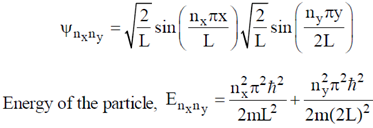


41. In an experiment on charging of an initially uncharged capacitor, an RC circuit is made with the resistance R = 10  and the capacitor C = 1000 µF along with a voltage source of 6V. The magnitude of the displacement current through the capacitor (in µA), 5 seconds after the charging has started is __________.
and the capacitor C = 1000 µF along with a voltage source of 6V. The magnitude of the displacement current through the capacitor (in µA), 5 seconds after the charging has started is __________.
Ans. (363.92)
Sol. Current in the circuit after time t is, 
Displacement current between the plates is equal to the current in the wire.
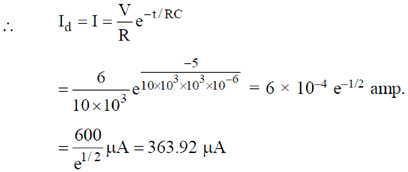
42. X-rays of wavelength 0.24 nm are Compton scattered and the scattered beam is observed at an angle of 60º relative to the incident beam. The Compton wavelength of the electron is 0.00243 nm. The kinetic energy of scattered electrons in eV is ___________
Ans. (26)
Sol. 

Kinetic energy of scattered electron Ek = loss in energy of X-ray photon


= (0.24 + 0.001215) nm = 0.241215 nm

43. GaAs has a diamond structure. The number of GaAs bonds per atom which have to be broken to fracture the crystal in the (001) plane is __________
Ans. (2)
Sol. Correct answer is (2)
44. A diode at room temperature (kT = 0.025 eV) with a current of 1 µA has a forward bias voltage Vf = 0.4 V.For Vf = 0.5 V, the value of the diode current (in µA) is __________
Ans. (54.598)
Sol. kT = 0.025 eV
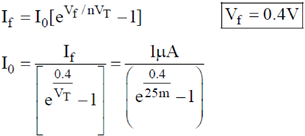
I0 = 1.125 × 10–13 A
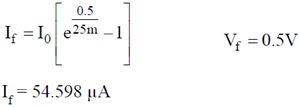
45. The power radiated by sun is 3.8 × 1026 W and its radius is 7 × 105 km. The magnitude of the poynting vector (in W/cm2) at the surface of the sun is __________
Ans. (6174.4)
Sol. 
46. Unpolarized light is incident on a calcite plate at an angle of incidence 50º, as shown in the figure. Take n0 = 1.6584 and ne = 1.4864 for calcite. The angular separation (in degrees) between the two emerging rays within the plate is ___________
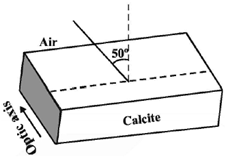
Ans. (3.51°)
Sol. The light is travelling in the perpendicular direction to the optic axis, so the refraction indices for ordinary and extraordinary rays are independent of angle of incident.
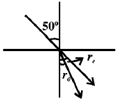
We have,



47. A rod is moving with a speed of 0.8c in a direction at 60º to its own length. The percentage concentration in the length of the rod is ________
Ans. (8.3)
Sol. Since the rod is along x-axis
Therefore, only x-component of velocity will make a significant effect on the length of the rod.
Apparent length of the rod

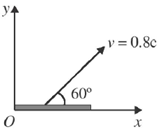
Percentage contraction in length

48. 
Ans. (1.3)
Sol. Given the state of the particle

49. In the given circuit, VCC = 10V and  = 100 for the n-p-n transistor. The collector voltage VC (in volts) is ___________
= 100 for the n-p-n transistor. The collector voltage VC (in volts) is ___________
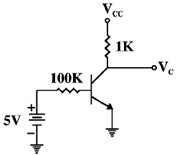
Ans. (5.7 or 5V)
Sol. If VBE = 0.7 V
–5 + IB.100k + 0.7 = 0 VBE = 0


VC = VCC – ICRC VC = 10 – 5 mA × 1k = 5V
VC = 10 – 4.3 mA × 1k = 5.7 V
50. In the hydrogen atom spectrum, the ratio of the longest wavelength in the Lyman series (final state n = 1) to that in the Balmer series (final state n = 2) is ___________.
Ans. (0.185)
Sol. Longest wavelength in Lymann series corresponds to n = 2  n = 1
n = 1
Longest wavelength in Balmer series corresponds to n = 3  n = 2
n = 2
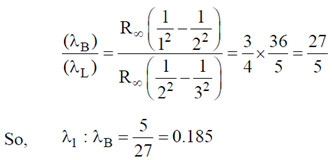
51. A plane electromagnetic wave of frequency 5 × 1014 Hz and amplitude 103 V/m, travelling in a homogeneous dielectric medium if dielectric constant 1.69, is incident normally at the interface with a second dielectric medium of dielectric constant 2.25. The ratio of the amplitude of the transmitted wave to that of the incident wave is __________
Ans. (0.92857)
Sol. The refractive index of first medium

And refractive index of second medium

52. For the arrangement given in the following figure, the coherent light source A, B and C have individual intensities of 2 mW/m2, 2 mW/m2 and 2 mW/m2, respectively at point P. The wavelength of each of the sources is 600 nm. The resultant intensity at point P (in mW/m2) is _____________
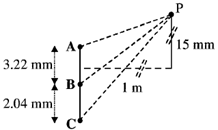
Ans. (5)
Sol. In the Young's double slit arrangement, the path difference, 
Where, 2d = distance between slits
D = distance between slits and screen
y = distance of the point P from the central bright fringe.
The path difference between the rays from A and B =  = 0.04830 mm = 48300 nm
= 0.04830 mm = 48300 nm
Now, 
So the path difference is the odd multiple of  and these wave interfere destructivity. Both sources i.e. A and B have the same intensities (same amplitude). So, the resultant intensity due to A and B at P is zero.
and these wave interfere destructivity. Both sources i.e. A and B have the same intensities (same amplitude). So, the resultant intensity due to A and B at P is zero.
We can conclude here that the intensity at P is only due to C i.e. 5 mW/m2
Correct answer is (5 mW/m2).
53. In a region of space, a time dependent magnetic field B(t) = 0.4t Tesla points vertically upwards. Consider a horizontal, circular loop of radius 2 cm in this region. The magnitude of the electric field (in mV/m) induced in the loop is ____________
Ans. (4)
Sol. 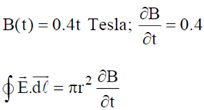

54. A homogeneous semi-circular plate of radius R = 3m is shown in the figure. The distance of the center of mass of the plate (in meter) from the point O is _____________

Ans. (1.273)
Sol. 
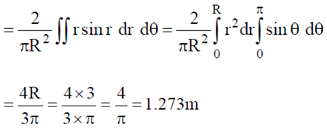
55. A uniform disk of mass m and radius R rolls, without slipping down a fixed plane inclined at an angle 30º to the horizontal. The linear acceleration of the disk (in m/sec2) is _______________
Ans. (3.267)
Sol. Linear acceleration

56. In the thermodynamic cycle shown in the figure, one mole of a monatomic ideal gas is taken through a cycle. AB is a reversible isothermal expansion at a temperature of 800 K in which the volume of the gas is doubled. BC is an isobaric contraction to the original volume in which the temperature is reduced to 300 K. CA is a constant volume process in which the pressure and temperature return to their initial values. The net amount of heat (in joules) absorbed by the gas in one complete cycle is ________
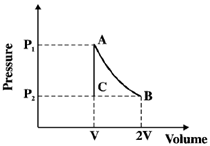
Ans. (452.28)
Sol. For complete cycle,


WBC = P2(VC – VB) = RTC – RTB = R(300 – 800) = –500R
WCA = 0
So, W = WAB+WBC+WCA = R × 800 ln 2 – 500 R= R[800 ln 2 – 500]= 452.28 J

57. A nozzle is in the shape of a truncated cone, as shown in the figure. The area at the wide end is 25 cm2 and the narrow end has an area of 1 cm2. Water enters the wider end at a rate of 500 gm/sec. The height of the nozzle is 50 cm and it is kept vertical with the wider end at the bottom. The magnitude of the pressure difference in kPa (1 kPa = 103 N/m2) between the two ends of the nozzle is _______
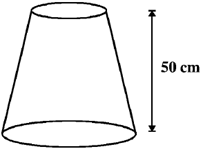
Ans. (17.48)
Sol. Given

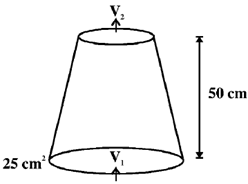
Equation continuity
V1A1 = V2A2
20 × 25 = V2 × 1
V2 = 500 cm/sec
Bernoulis theorem


58. One gram of ice at 0ºC is melted and heated to water at 39ºC. Assume that the specific heat remains constant over the entire process. The latent heat of fusion of ice is 80 Calories/gm. The entropy change in the process (in Calories per degree) is ___________
Ans. (0.427)
Sol. 
59. A block of mass 2 kg is at rest on a horizontal table. The coefficient of friction between the block and the table is 0.1. A horizontal force 3 N is applied to the block. The speed of the block (in m/s) after it has moved a distance 10 m is ___________
Ans. (3.162)
Sol. 
v2 = 30 – 0.1 × 2 × 10 × 10
= 30 – 20

60. Consider a 20 µm diameter p-n junction fabricated in silicon. The donor density is 1016 per cm3. The charge developed on the n-side is 1.6 × 10–13 C. Then the width (in µm) of the depletion region on the n-side of the p-n junction is _________
Ans. (0.32)
Sol. Charge developed on n-side


